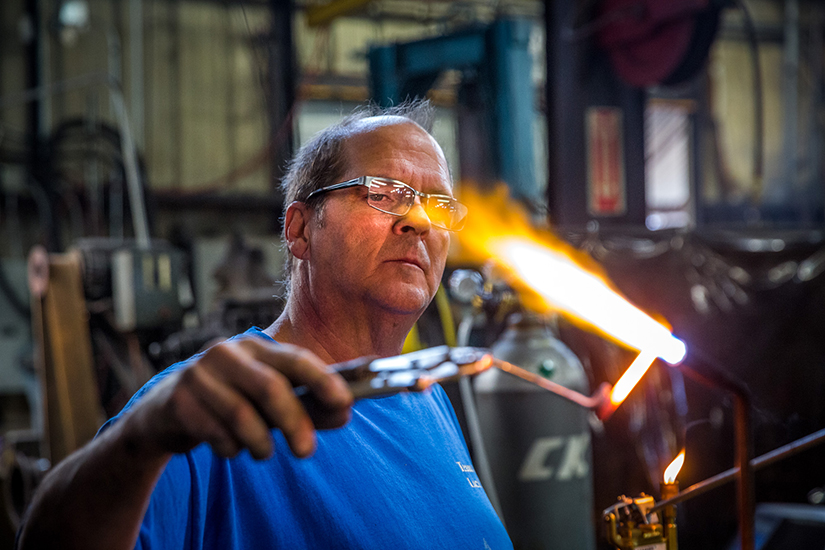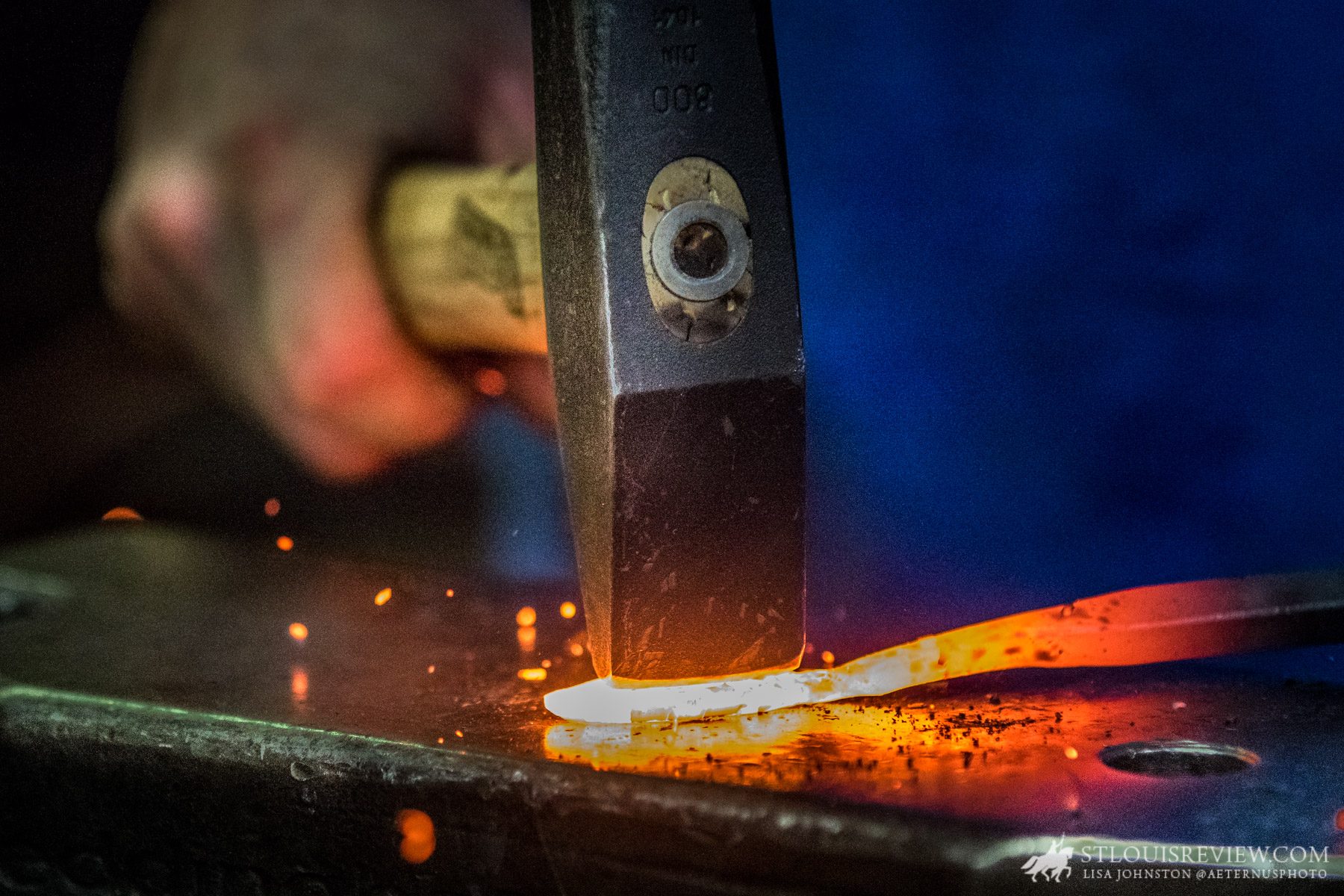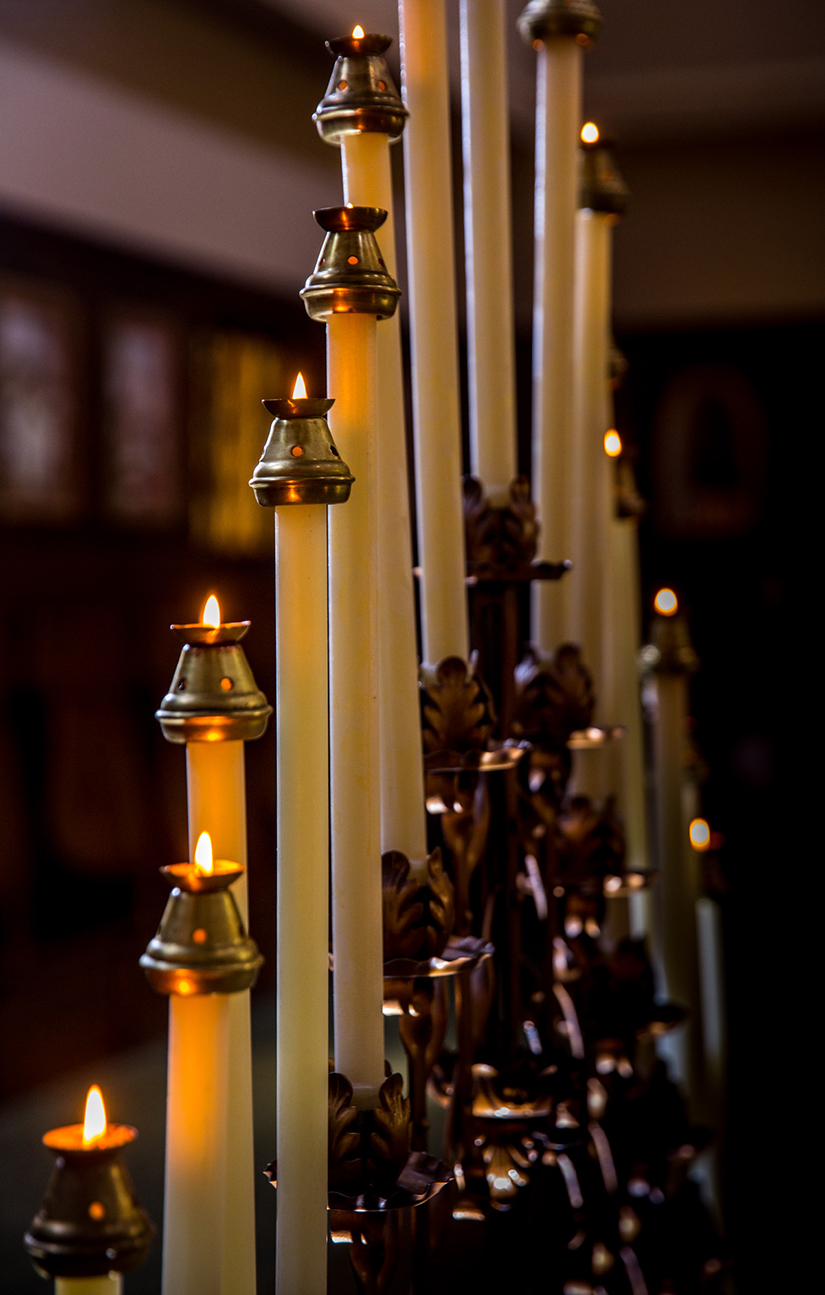During the sacred Triduum, just before the sun peeks over the horizon, the Religious Sisters of Mercy assemble in the darkness of their convent chapel for prayer. Only a small light beams from 15 candles.
The intimate gathering is quiet and somber, only pierced by their chanting of the Psalms and Lamentations of Jeremiah. One by one, the candles are extinguished as the sisters recall with gratitude the passion and death of Jesus.
 Restorations Plus of St. Louis was commissioned to create a Tenebrae hearse for the Sisters of Mercy. The five-foot iron candelabra features wheat and grapes, symbolizing the bread and wine that becomes Jesus’ Body and Blood.Photo Credits: Lisa Johnston
Restorations Plus of St. Louis was commissioned to create a Tenebrae hearse for the Sisters of Mercy. The five-foot iron candelabra features wheat and grapes, symbolizing the bread and wine that becomes Jesus’ Body and Blood.Photo Credits: Lisa JohnstonSince their founding in Alma, Mich., in the 1970s, the Religious Sisters of Mercy hold a Tenebrae service before dawn on the Holy Thursday, Good Friday and Holy Saturday. The prayers of Tenebrae include the Liturgy of the Hours: Office of Readings and Morning Prayer (formerly Matins and Lauds), commemorating Jesus’ passion and death. Quite literally, Tenebrae in Latin means “darkness” or “shadows.” The readings are taken from the Old Testament and point to how Christ saved all people from death and sin (darkness), and brings life (light) to the world through His sacrifice on the cross.
This year, the Religious Sisters of Mercy will use a new Tenebrae hearse at their service — but certainly not the kind of hearse used to transport the deceased from church to cemetery. The sisters commissioned Restorations Plus of St. Louis to create an iron hearse, a triangular candelabra typically featuring 15 candles.
“The significance of this is that it is about Jesus being plunged into the darkness for our redemption,” said Sister Marysia Weber, RSM. “The purpose is to remember the somber events that have occurred in the last days of Jesus’ life.”
History
The structure of Tenebrae has certainly changed over the centuries with the revisions in the liturgy. Typically Tenebrae services would last for a couple of hours. Msgr. Martin Hellreigel, a priest of the Archdiocese of St. Louis and a key figure in the liturgical reforms at the time of the Second Vatican Council, created a modified Tenebrae service for parishes. Maintaining the general structure, he shortened the readings and psalms to allow for a condensed service lasting about 45 minutes.
Today, most Catholic churches do not offer Tenebrae services. Other churches, including Anglican, Lutheran and Orthodox, also sometimes perform Tenebrae services.
“The celebration of Tenebrae, like all celebrations of the Liturgy of the Hours, is intended to heighten the participation of the Church in the liturgies of the Triduum on these three sacred days,” said Sister Mary Kathleen Ronan, RSM. “The Church offers the faithful an occasion to recall the institution of the Eucharist on Holy Thursday evening at the Mass of the Lord’s Supper; and on Good Friday, we participate the liturgical celebration of the Passion of the Lord. Most importantly, on Holy Saturday night, the whole Church reaches the pinnacle of the liturgical year and celebrates the victory of Christ, who brings light and life to all who seek Him.”
Ceremony
During Tenebrae, one by one, the candles on the hearse are extinguished, until only one — the Christ candle — remains. The Christ candle is carried out, leaving the room in total darkness.
 Restorations Plus of St. Louis was commissioned to create a Tenebrae hearse for the Sisters of Mercy. The five-foot iron candelabra features wheat and grapes, symbolizing the bread and wine that becomes Jesus’ Body and Blood.Photo Credits: Lisa Johnston
Restorations Plus of St. Louis was commissioned to create a Tenebrae hearse for the Sisters of Mercy. The five-foot iron candelabra features wheat and grapes, symbolizing the bread and wine that becomes Jesus’ Body and Blood.Photo Credits: Lisa JohnstonThe participants punctuate the silence with the
strepitus, which in Latin is roughly translates as “loud noise.” Some describe the noise as symbolizing Jesus’ death, or as the earthquake that was said to have happened at the moment of His death. Others have described it as the convulsion of nature when Christ died, or the sound of the tomb’s door closing.
The somber service has a definite monastic influence, explained Father Wetta, OSB, of St. Louis Abbey. The Benedictines host a Tenebrae service every year on Good Friday.
“It is the quietest service out of any of them, and it gets gradually quieter — the last Psalm is said to be the quietest, moving into the tomb. As monks, our lives are to be a constant Lent. We keep the day of our death hourly before our lives. So this moment of silence and contemplation is very characteristic of the Benedictines.”
Second to the Eucharist
The Sisters of Mercy worked with Michele Bowman and Rich Dean of Restorations Plus to create the hearse. The local company, which restores religious statues and artwork, oversaw the design. The company was repairing a statue at the sisters’ convent when the sisters learned that they provide iron work and blacksmithing services — which led to a discussion about making the hearse.
The five-foot iron hearse features wheat and grapes, symbolizing the bread and wine that becomes Jesus’ Body and Blood. The theme is intentional, explained Sister Mary Kathleen Ronan.
“The Catechism teaches us that the passion, death, Resurrection and Ascension of Christ present in every Eucharist is timeless,” she said. “If you think about the sacrifice of the Lord on the cross, that sacrifice is present at every Mass, and we are called to join our own sacrifices with His.”
With the Eucharistic celebration receiving highest priority in the life of the Church, the Liturgy of the Hours, which is the centerpiece of Tenebrae, is most definitely right behind the Mass in terms of importance.
The foundress of the Religious Sisters of Mercy, Venerable Mother Catherine McAuley, had a great devotion to the passion of Christ, said Sister Mary Kathleen Ronan. “Our celebration of Tenebrae flows from that devotion.”
Tenebrae hearse
 A Tenebrae hearse that will be used by the Discalced Carmelite Nuns in St. Louis.Photo Credits: Lisa Johnston
A Tenebrae hearse that will be used by the Discalced Carmelite Nuns in St. Louis.Photo Credits: Lisa JohnstonThe Tenebrae hearse is the triangular candlestick used in the Tenebrae service. The name is derived, through the French herse, from the Latin herpex, which means a harrow, and is the same as that now used in connection with funeral processions. The funeral hearse was originally a wooden or metal framework, which stood over the bier or coffin and supported the pall. It was provided with numerous prickets to hold burning tapers, and, owing to the resemblance of these prickets to the spikes or teeth of a harrow, was called a hearse. Later on, the word was applied, not only to the construction above the coffin, but to any receptacle in which the coffin was placed. Thus it came to denote the vehicle in which the dead are carried to the grave. Likewise in the case of the Tenebrae hearse, the term was employed because the prickets were supposed to resemble the teeth of a harrow. The triangular candlestick for the Tenebrae dates back at least as far as the seventh century, being mentioned in an ordo of that period published by Mabillon. The number of candles, however, has varied at different times and in different places.
Source: New Advent
Tenebrae services
• Discalced Carmelites, 9150 Clayton Road in Ladue, 7:30 p.m. Sunday, March 25.
• St. Justin Martyr, 11914 Eddie And Park Road in Sunset Hills, 7 p.m. Wednesday, March 28.
• St. Margaret Mary Alacoque, 4900 Ringer Road in Oakville, 7 p.m. Wednesday, March 28.
• St. Louis Abbey, 500 S. Mason Road in Creve Coeur, 8 p.m. Good Friday, March 30.
• St. Michael the Archangel, 7622 Sutherland Ave. in Shrewsbury, 8:30 p.m. Good Friday, March 30. (A celebration of the Lord’s Passion will take place at 7 p.m.)
• Epiphany, 6596 Smiley Ave. in south St. Louis, 9 p.m. Good Friday, March 30.